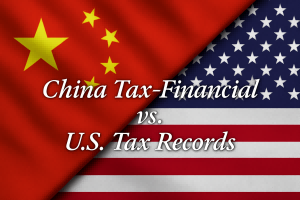Contents
Introduction:
When evaluating Chinese companies, overseas investors, lawyers, and business professionals often find it difficult to access detailed financial and tax information. In many Western countries, “tax records” are generally public or easily obtainable through official filings and audited reports. However, the situation in China is fundamentally different.
In the Chinese context, besides formal tax filings submitted to the tax authorities, there is another widely used but unofficial concept known as the Tax-Financial Version. This version is prepared primarily for tax compliance purposes and often does not fully reflect the company’s actual financial performance or operational status.
Understanding the difference between the Tax-Financial Version and Company Tax Records is essential for anyone considering partnerships, investments, or due diligence with Chinese companies. Especially for Small and Medium-sized Enterprises (SMEs) in China, most financial data remains undisclosed to the public, as companies have the legal right to choose whether to make their financial information public.
This article explains the key differences between tax-financial versions in China and U.S tax records, explores the reasons behind limited financial disclosure, and offers practical advice for international investors on how to conduct effective due diligence when dealing with Chinese companies.
1. What is the “Tax-Financial Version” in China?
The “Tax-Financial Version” is a colloquial term used in China, typically referring to the version of financial reports submitted by enterprises to the tax authorities for tax filing purposes. It is not an officially defined legal term, but is widely used in commercial transactions and due diligence practices.
The “Tax-Financial Version” often includes:
-
Tax filing forms for various types of taxes, such as VAT and Corporate Income Tax;
-
Balance sheets and profit and loss statements based on the company’s accounts;
-
Financial reports specifically prepared for tax reporting, which may differ from internal or true financial accounts;
-
Invoice records generated by tax control equipment and their consistency with tax filings.
It is important to note that the financial information in the “Tax-Financial Version” is organized primarily to comply with tax regulations and does not represent a fully audited financial statement nor the complete operating status of the company.
2. Comparison Between “Tax Records” and “Tax-Financial Versions” in China and the United States
| Chinese Tax Concept | Common Misunderstanding by the U.S. Investors | Actual Situation |
|---|---|---|
| Tax Registration Number (Unified Social Credit Code) | Equivalent to EIN | The Unified Social Credit Code (18 digits) integrates business registration, taxation, and social insurance accounts. |
| “Tax-Financial Version” Reports | Equivalent to GAAP Financial Reports | Primarily for tax filing purposes; many SMEs optimize their reports for tax efficiency. |
| Value-Added Tax (VAT) | Similar to Sales Tax | More complex mechanism, including input VAT deductions and invoice chains, unlike U.S. sales tax. |
| Corporate Income Tax Filing | Comparable to Form 1120 | While both are corporate tax filings, China emphasizes simplified declarations for SMEs. |
| Financial Statements | Presumed to be Audited | Most SMEs’ financials are unaudited and prepared solely for tax filing needs. |
3. Are China’s “Tax-Financial Versions” Equivalent to U.S. “Tax Records”?
| Item | China | United States |
|---|---|---|
| Taxpayer Identification | Unified Social Credit Code | EIN (Employer Identification Number) |
| Financial Standards | Enterprise Accounting Standards (Tax-focused) | GAAP (Transparency-focused) |
| Purpose of Financial Reports | Primarily for tax filing | For investors, compliance, and tax authorities |
| Disclosure Mechanism | Optional for enterprises | Mandatory for most corporations |
| Audit Requirements | Not mandatory | Mandatory for listed and large companies |
| Tax Filing System | Invoice-driven electronic regulation | Self-managed bookkeeping and Form-based filings |
4. Why Is the “Tax-Financial Version” of Most SMEs in China Not Publicly Available?
According to China’s regulatory framework, corporate financial and tax information is classified as “non-public sensitive information.” Specifically:
-
Only tax authorities in China have legitimate access to the complete “Tax-Financial Version” reports. Even if a company is willing to disclose, the filings must go through the official tax systems.
-
In the National Enterprise Credit Information Publicity System, companies have the right to choose “non-disclosure” of their financial data. Most SMEs, for reasons of confidentiality or tax optimization, opt not to disclose their financial statements.
-
SMEs are legally entitled not to disclose their financial data. Therefore, even if a company submits its annual report, its financial information is often absent from public systems, making it impossible for external investors to view critical financial details such as revenue, profit, or tax liabilities.
5. How to Access This Information? GWBMA’s Role and Due Diligence Services
In general, corporate financial and tax information in China falls under the category of “non-public information,” and is only legitimately accessible to tax authorities such as the State Taxation Administration and its subordinate bureaus. Even in the National Enterprise Credit Information Publicity System, only basic statuses like tax filing compliance or tax anomalies are displayed, without disclosing detailed financial statements or tax breakdowns.
Furthermore, SMEs have the right to choose “non-disclosure” when submitting their annual reports, meaning that even compliant filings may not reveal any financial data to the public.
Conclusion:
Therefore, unless authorized by the company itself or accessed through tax authority-sanctioned public information channels, no third party has the right to directly access a company’s complete “Tax-Financial Version.” For this reason, GWBMA, as a third-party verification agency, relies on the National Enterprise Credit Information Publicity System, other authorized platforms, and publicly available tax credit information from local tax authorities, combined with materials provided through company cooperation, to reconstruct the most accurate possible view of a company’s financial and tax situation, helping clients conduct risk assessments and informed business decisions.



